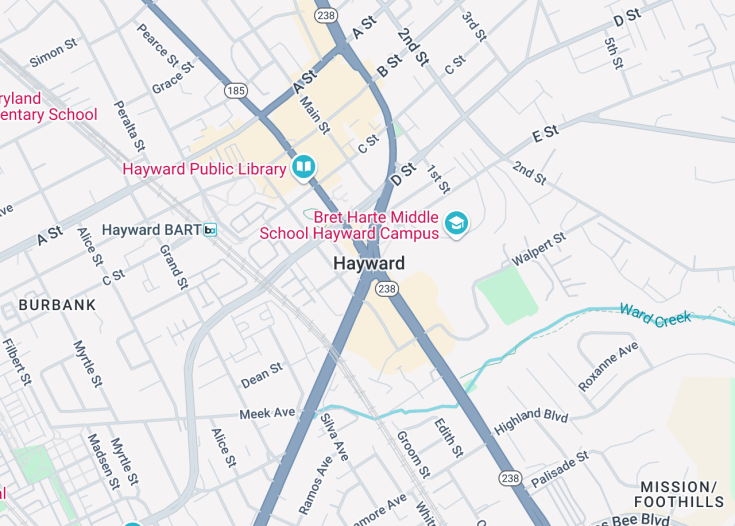Hayward, located in the heart of California’s Bay Area, offers a unique blend of urban charm and natural beauty. This vibrant city is known for its rich cultural heritage, diverse population, and proximity to major metropolitan areas like San Francisco and San Jose.
Visitors can explore a variety of attractions, including the Hayward Japanese Gardens, the oldest Japanese garden in California, and the historic downtown with its eclectic mix of shops and restaurants. The city also serves as a gateway to the scenic beauty of the broader Bay Area, making it a perfect spot for both relaxation and adventure.
When visiting Hayward, make sure to check out the local farmers markets — a great spot to experience the city’s vibrant community life and fresh California produce.
Plan your visit to coincide with one of Hayward’s numerous cultural festivals, such as the Zucchini Festival or the Latino Heritage Festival, to experience local traditions firsthand.
Top things to do & see in Hayward
Select the following sights and activities to discover best tickets and tours available in Hayward.
Hayward: Gateway to the Bay
| Country | California (USA) |
| Time in Hayward | GMT-7 |
| Language spoken | English |
| Population | 162,954 (U.S. Census Bureau) |
| Currency | United States Dollar (USD, $) |
| Airports |
|
Hayward in California is a vibrant and diverse community located in the heart of the Bay Area. With its rich history dating back to its founding in 1852, Hayward has evolved from an agricultural hub to a thriving suburban city.
It offers a mix of residential, business, and industrial spaces, alongside extensive recreational areas and parks, making it an ideal location for both families and businesses.
Where is Hayward?
Hayward is situated on the eastern shore of the San Francisco Bay in Alameda County, centrally positioned between San Jose and San Francisco.
Distances:
| Route | Distance by car | Time by car |
|---|---|---|
| San Francisco to Hayward | 26 miles | 32 minutes |
| San Jose to Hayward | 27 miles | 29 minutes |
| Oakland to Hayward | 15 miles | 20 minutes |
What is Hayward famous for?
Hayward is well-known for its historical landmarks, such as the Buffalo Bill’s Brewery, one of the first brewpubs in California, and the annual Hayward Zucchini Festival, drawing visitors from across the Bay Area.
History
Hayward, located in the heart of California’s Bay Area, boasts a rich and evolving history. From its early days inhabited by native peoples to its growth as a vibrant suburban city, Hayward has continually adapted and flourished through the centuries.
Pre-19th Century: Native Lands
Before European settlement, the area now known as Hayward was home to the Ohlone Native American peoples. These indigenous groups lived primarily along the coast and in the valleys of Northern California, thriving on the rich resources provided by the land and the San Francisco Bay.
19th Century: Spanish Influence and American Settlement
The Spanish were the first Europeans to explore the region, incorporating it into their vast mission lands. However, it wasn’t until the mid-1800s that the area began to develop significantly. William Hayward arrived in 1851, opening a hotel catering to gold miners. His establishment shaped the nucleus around which the community grew, eventually taking his name.
Early 20th Century: Industrial Growth
During the early 1900s, Hayward became a booming agricultural hub, particularly noted for its extensive production of tomatoes, peaches, and other fruit crops. The construction of canneries and other food processing facilities supported local agriculture and facilitated nationwide distribution of its products.
Mid to Late 20th Century: Urban Expansion
Post World War II, Hayward saw a massive influx of residents as part of the broader suburban expansion of the Bay Area. It transitioned from a small agricultural center into a more diversified urban area. Industry and business thrived, and educational institutions like California State University, East Bay were established, enhancing the city’s cultural and social landscape.
21st Century: Modern Development
In recent years, Hayward has focused on community development and environmental initiatives. It has invested in green technology and infrastructure, striving to balance suburban growth with sustainability. The city continues to evolve, maintaining its historic roots while adapting to the needs of its diverse population.
Visit Hayward
Attractions and Activities in Hayward
Hayward offers a variety of attractions and activities that cater to both history enthusiasts and nature lovers. Visitors can explore the Hayward Japanese Gardens, the oldest Japanese garden in California, or hike the scenic trails at Garin Regional Park.
For a closer look at the city’s history, the Hayward Area Historical Society provides insights into the local heritage. Families will enjoy the Sulphur Creek Nature Center, an rehabilitation facility for local wildlife that offers educational programs.
Festive Spirit of Hayward
Hayward hosts several events throughout the year that showcase its vibrant community spirit. One of the highlights is the Hayward Zucchini Festival, held every August, celebrating local agriculture and community.
Additionally, the city brightens up during the winter with the annual Hayward Light Up the Season event, which includes a tree lighting ceremony and a holiday parade.
Best time to visit Hayward
The best time to visit Hayward is during the spring or early fall when the weather is mild and pleasant, ideal for outdoor activities and exploring the city’s parks and nature preserves.
Additionally, these seasons coincide with several local festivals and events, providing a richer experience of Hayward’s culture and community life.
Is Hayward worth visiting?
Hayward is certainly worth visiting, particularly for those who appreciate natural beauty and local history. Its diverse array of parks, historical sites, and cultural activities provide a rich, enjoyable experience.
Furthermore, its proximity to other Bay Area cities and attractions makes it a convenient and appealing destination for travelers looking to explore the wider region.










